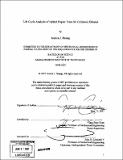| dc.contributor.advisor | Yang Shao-Horn. | en_US |
| dc.contributor.author | Huang, Jessica J | en_US |
| dc.contributor.other | Massachusetts Institute of Technology. Dept. of Mechanical Engineering. | en_US |
| dc.date.accessioned | 2009-03-20T19:55:46Z | |
| dc.date.available | 2009-03-20T19:55:46Z | |
| dc.date.copyright | 2007 | en_US |
| dc.date.issued | 2007 | en_US |
| dc.identifier.uri | http://hdl.handle.net/1721.1/40429 | |
| dc.description | Thesis (S.B.)--Massachusetts Institute of Technology, Dept. of Mechanical Engineering, 2007. | en_US |
| dc.description | Includes bibliographical references (leaves 38-41). | en_US |
| dc.description.abstract | The main purpose of this paper is to assess the energy and environmental benefits of cultivating hybrid poplars as a biomass crop for cellulosic ethanol. A "Life Cycle Assessment" (LCA) methodology is used to systematically evaluate the hybrid poplar's energy input and output as well as greenhouse gas (GHG) emissions. The system boundary is divided into three sections, agriculture, transportation, and ethanol processing. In this LCA, only energy from fossil fuels is accounted for, and only energy yield from ethanol yield is considered. Energy demands and associated emissions for all operations are divided equally over the total biomass harvested over a 10 year timeline. Ultimately, the net energy ratio, the amount of clean energy produced over the amount of fossil fuels consumed, and the amount of carbon dioxide emitted during the cultivation process is compared to those of current forms of fuel and other renewable resources. The net energy ratio was calculated to be in the range of 5.82 to 8.55, which was found to be higher than both gasoline and corn ethanol. | en_US |
| dc.description.abstract | (cont.) The carbon dioxide emission was calculated to be in the range of 2.42 to 3.55 grams CO2 per MJ output, and was lower than the net emissions of both gasoline and corn ethanol. However, in comparing to other renewable resources, such as solar and wind, hybrid poplars were evaluated to be less optimal in energy efficiency and GHG emissions. | en_US |
| dc.description.statementofresponsibility | by Jessica J. Huang. | en_US |
| dc.format.extent | 48 leaves | en_US |
| dc.language.iso | eng | en_US |
| dc.publisher | Massachusetts Institute of Technology | en_US |
| dc.rights | M.I.T. theses are protected by
copyright. They may be viewed from this source for any purpose, but
reproduction or distribution in any format is prohibited without written
permission. See provided URL for inquiries about permission. | en_US |
| dc.rights.uri | http://dspace.mit.edu/handle/1721.1/7582 | en_US |
| dc.subject | Mechanical Engineering. | en_US |
| dc.title | Life cycle analysis of hybrid poplar trees for cellulosic ethanol | en_US |
| dc.type | Thesis | en_US |
| dc.description.degree | S.B. | en_US |
| dc.contributor.department | Massachusetts Institute of Technology. Department of Mechanical Engineering | en_US |
| dc.identifier.oclc | 191700399 | en_US |

